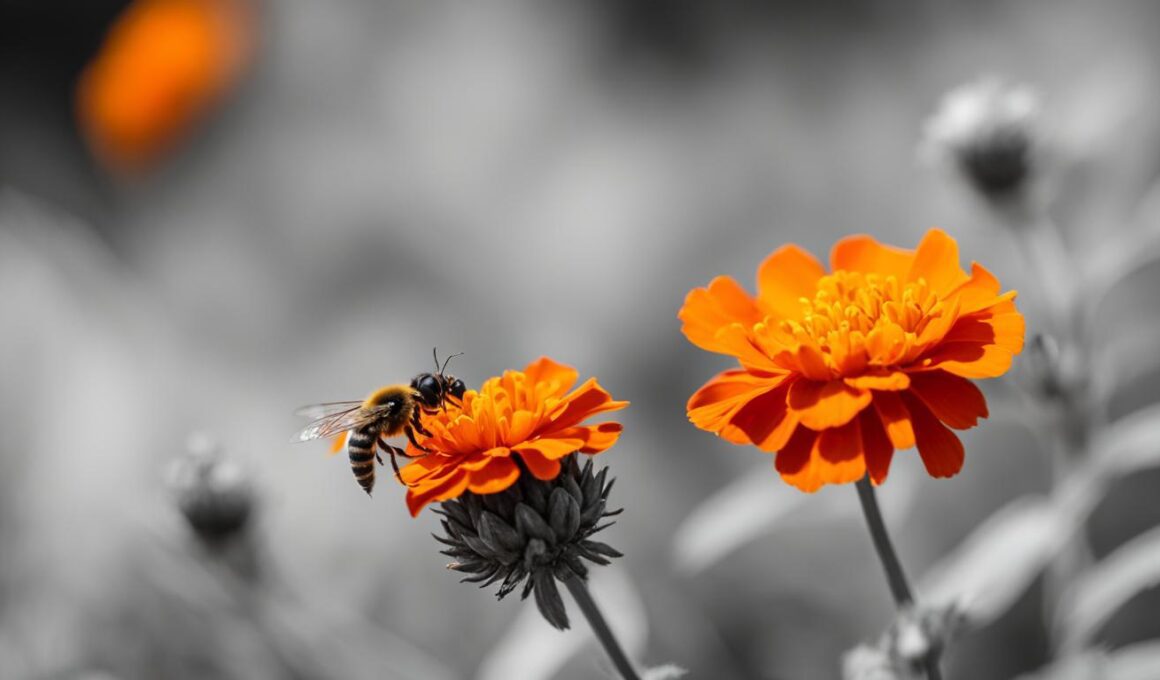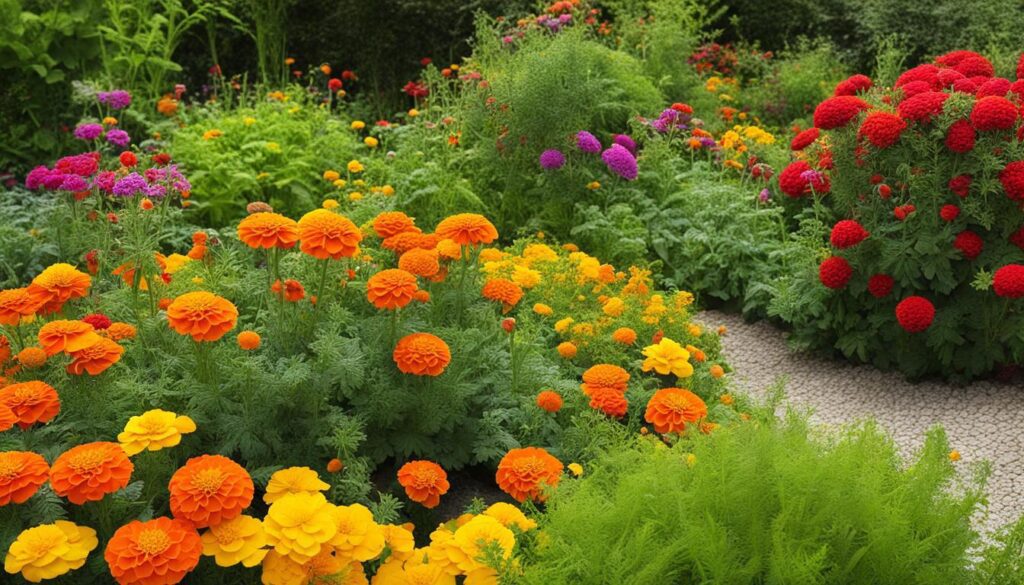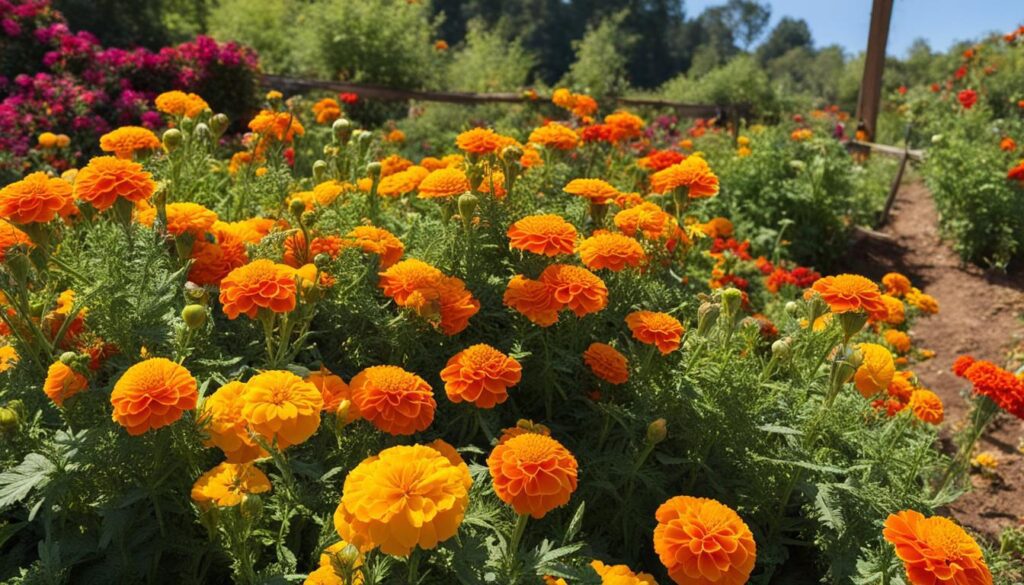Welcome to our article on the fascinating world of companion planting and the role that marigolds play as pollinators in your garden. If you’re looking to enhance your gardening experience and boost the health and productivity of your crops, this is the article for you. Discover the power of marigolds and how they can transform your garden into a thriving ecosystem.
Key Takeaways:
- Companion planting is an effective technique that involves planting different crops together to benefit each other.
- Marigolds can act as natural pest deterrents and improve soil quality when planted alongside tomatoes and beans.
- By creating a diverse garden through companion planting, you can attract pollinators, repel pests, and promote healthier plant growth.
- Getting started with companion planting is easy, requiring research, planning, and regular care for your plants.
- Marigolds are excellent companion plants for tomatoes, beans, and cucumbers, providing various benefits such as pest control and shade.
What is Companion Planting?
Companion planting is a gardening technique that involves planting different crops together in the same plot to create beneficial relationships. By strategically pairing plants, you can maximize your garden’s potential and create a more diverse and healthy environment. This practice has been used for centuries and is gaining popularity among modern gardeners.
One of the main benefits of companion planting is pest control. By interplanting certain crops, you can naturally repel pests and reduce the need for chemical pesticides. For example, planting marigolds alongside tomatoes can deter insects like aphids and whiteflies. Additionally, companion planting can attract beneficial insects like ladybugs and lacewings, which feed on garden pests.
Another advantage of companion planting is improved soil quality. Some plants have the ability to fix nitrogen in the soil, benefiting neighboring crops. For instance, planting beans alongside corn can provide a natural source of nitrogen, which promotes healthier corn growth. Similarly, certain plants have deep root systems that help break up compacted soil and improve drainage.
In addition to pest control and soil improvement, companion planting can provide shade and create microclimates within your garden. For example, planting taller crops like sunflowers near smaller plants can provide shade and protection from excessive heat. This can be especially beneficial during hot summer months.
Benefits of Companion Planting:
- Natural pest control
- Improved soil quality
- Shade and microclimate creation
- Better pollination
- Increased biodiversity
Companion planting is a time-tested and environmentally friendly way to improve your garden’s health and productivity. By diversifying your garden and harnessing the power of companion plants, you can create a thriving ecosystem that benefits both you and the environment.
How to Get Started with Companion Planting
Getting started with companion planting is an exciting way to enhance your garden’s health and productivity. By combining different crops strategically, you can create a harmonious ecosystem that benefits all the plants involved. Follow these steps to embark on your companion planting journey:
- Choose the vegetables you want to grow: Start by selecting the vegetables you wish to cultivate in your garden. Consider the specific needs and preferences of each plant, such as sunlight requirements and soil preferences.
- Research which plants have beneficial relationships: Look for plants that have beneficial relationships with each other. Some plants repel pests, while others attract beneficial insects like pollinators. Additionally, certain plants can provide shade or help improve soil quality. Make a list of compatible plant combinations.
- Plan your garden plot accordingly: Map out your garden plot and decide where each crop will be planted. Take into account factors like sunlight exposure, spacing requirements, and companion plant compatibility.
- Plant your crops in designated spots: Once you have planned your garden plot, it’s time to start planting. Follow the recommended planting guidelines for each crop, ensuring proper spacing and depth.
- Water and care for your plants as needed: After planting, provide your crops with adequate water and care according to their specific needs. Regularly monitor your plants for signs of pests or nutrient deficiencies and take appropriate action.
- Monitor and make adjustments: Keep a close eye on your garden and make adjustments as necessary. If you notice any issues or imbalances, consider making changes to your companion plant combinations or garden layout.
By following these steps, you’ll be well on your way to creating a thriving garden through the power of companion planting.
The Best Plants to Use for Companion Planting
Companion planting is an effective gardening technique that involves planting different crops together to create mutually beneficial relationships. When it comes to choosing companion plants, marigolds are among the best options for enhancing the health and productivity of your garden. Here are some of the top companion plants to consider:
- Marigolds: These vibrant flowers are not just for aesthetics. Marigolds repel pests that can damage tomatoes, making them excellent companions for tomato plants. They also add a pop of color to your garden.
- Tomatoes: Tomatoes thrive when planted alongside basil. The aromatic scent of basil deters pests and can improve the flavor of your tomatoes. Plus, basil’s shallow roots make it a great companion for deep-rooted tomatoes.
- Beans: Beans are a nitrogen-fixing crop, which means they take nitrogen from the air and convert it into a form that other plants can use. Planting beans alongside cucumbers or corn can help provide them with an extra boost of nitrogen.
- Cucumbers: Cucumbers benefit from companion plants that provide shade and attract pollinators. Sunflowers are an excellent choice, as their tall stalks can create shade for the cucumber plants, while also attracting bees and other pollinators.
Why Marigolds are Great Companion Plants
Marigolds are not only visually appealing, but they also offer numerous benefits as companion plants. Their strong scent repels pests like aphids, nematodes, and whiteflies, helping to protect neighboring plants from damage. Additionally, marigolds attract beneficial insects such as ladybugs and hoverflies, which feed on garden pests. These flowers also have an extensive root system that improves soil structure and helps retain moisture, benefiting nearby plants.
Creating a Thriving Companion Garden
When planning your companion garden, consider the specific needs and preferences of each plant. Some plants may have conflicting requirements, so make sure to research their compatibility before placing them together. Additionally, vary the heights and growth habits of your companion plants to create a diverse and balanced garden. Regularly monitor your garden for signs of pests or nutrient deficiencies, and take appropriate action to address any issues that arise. By carefully selecting and pairing your plants, you can create a thriving and harmonious companion garden.
My Personal Experience with Companion Planting
Companion planting has been a game-changer for my vegetable garden. I was initially skeptical, but after implementing this technique, I’ve seen remarkable improvements in my plants’ health and productivity. The concept of planting certain crops together to create beneficial relationships sounded simple enough, but the results have exceeded my expectations.
One of the main benefits I’ve experienced is fuller and more flavorful tomatoes. By planting marigolds alongside my tomato plants, I’ve managed to deter pests that previously damaged the fruit. Not only do my tomatoes look more vibrant, but they also taste better. Additionally, my bean harvest has been incredibly abundant since I started companion planting. Beans and marigolds have a mutually beneficial relationship: beans fix nitrogen in the soil, providing nutrients for the marigolds, while the marigolds help distract pests away from the beans.
Another success story has been my cucumber plants. Initially, I struggled to get them to thrive, but after implementing companion planting techniques, they’ve really taken off. I planted sunflowers near my cucumber patch, which provide shade to protect the delicate cucumber plants from excessive sun and heat. The sunflowers also attract pollinators, ensuring that my cucumber flowers are properly pollinated, resulting in better fruit development and increased yields.
The benefits of companion planting
- Improved pest control
- Enhanced soil quality
- Attracted pollinators
- Increased crop yields
Companion planting has transformed my vegetable garden. I highly recommend giving it a try if you’re seeking improved results. The key is to research which plants have beneficial relationships and plan your garden layout accordingly. With a little experimentation, you’ll be amazed at the difference it can make.
Overall, my personal experience with companion planting has been nothing short of remarkable. If you’re struggling with your vegetable garden or looking to maximize your yields, I encourage you to explore companion planting. It’s a natural, sustainable way to improve your garden’s health and productivity, and the results are truly rewarding.
The Benefits of Companion Planting with Marigolds
Companion planting with marigolds offers numerous benefits for your garden. When you plant marigolds alongside other crops, you can enjoy improved pollination and increased crop yields. Marigolds have vibrant, attractive flowers that act as beacons to pollinators like bees and butterflies. These pollinators play a crucial role in fertilizing flowers and ensuring the successful production of fruits and vegetables.
In addition to attracting pollinators, marigolds have natural pest-repellent properties. Their strong scent can deter pests such as aphids, nematodes, and whiteflies, which often damage neighboring plants. By including marigolds in your companion planting strategy, you create a natural barrier that helps protect your garden from these destructive pests.
Moreover, marigold flowers can serve ornamental purposes, adding beauty and color to your garden. You can also consider selling marigold blooms to flower enthusiasts or as cut flowers for special occasions, providing an additional source of income.
Overall, companion planting with marigolds offers a range of benefits, including improved pollination, increased crop yields, pest control, and ornamental value. Incorporating marigolds into your garden not only enhances its overall health and productivity but also adds aesthetic appeal.
Case Study: Marigolds and Moringa Orchards in India
In a fascinating case study conducted in South India, researchers explored the benefits of companion planting marigolds alongside moringa trees in orchards. This innovative technique aimed to enhance pollination and ultimately improve crop yields. The findings revealed significant positive effects on the overall productivity and biodiversity of the orchards.
The study focused on the interaction between marigolds, moringa trees, and flower-visiting insects. By planting marigolds in the orchard, researchers observed a remarkable increase in the abundance and diversity of these beneficial insects. This, in turn, led to enhanced pollination, resulting in higher crop yields for the moringa trees.
The orchards with marigolds and red gram crops saw a striking 30% increase in the harvestable moringa fruits compared to those without companion planting. This improvement in yield demonstrates the potential impact of companion planting with marigolds in agricultural settings.
Conclusion
Companion planting, especially with marigolds, is a game-changer for improving your garden. By harnessing the power of beneficial plant relationships, you can create a thriving and productive garden space. The inclusion of marigolds in your companion planting strategy offers numerous advantages.
Firstly, marigolds attract important pollinators to your garden, boosting the pollination process and leading to increased crop yields. This means you can enjoy a bountiful harvest of delicious fruits and vegetables.
Secondly, marigolds act as natural pest deterrents, protecting your other plants from harmful insects. By including marigolds in your garden, you can reduce the need for chemical pesticides and promote a healthier ecosystem.
In conclusion, companion planting, with a focus on marigolds, provides a simple and effective solution for achieving improved gardens. By implementing this technique, you can create healthier plants, deter pests, and attract pollinators. So, give it a try and unlock the secret of marigolds as invaluable companions in your garden.
Are Marigolds Effective Pollinators for Other Plants?
Vibrant marigold annual plants are effective pollinators for other plants. Their bright blooms attract beneficial insects like bees and butterflies, which help in the pollination process. Planting marigolds near vegetable gardens or fruit trees can increase the yield of crops through enhanced pollination.
FAQ
What is companion planting?
Companion planting is the process of planting different crops together to benefit each other. It involves creating favorable relationships between plants to repel pests, attract pollinators, and provide shade.
How do I get started with companion planting?
To get started with companion planting, choose the vegetables you want to grow, research which plants have beneficial relationships with each other, plan your garden plot accordingly, plant your crops in designated spots, and water and care for your plants as needed. Monitor your garden and make adjustments as necessary.
Which plants are best for companion planting?
Marigolds are excellent companion plants for tomatoes, beans, and cucumbers. They deter pests, attract pollinators, and improve soil quality. Other popular companion plants include sunflowers, which provide shade and attract pollinators, and beans, which fix nitrogen in the soil.
What are the benefits of companion planting with marigolds?
Companion planting with marigolds offers several benefits. Marigolds attract pollinators, leading to improved pollination and increased crop yields. They also have pest-repellent properties, which can help protect neighboring plants from damage. Additionally, marigold flowers can be used for ornamental purposes or sold for extra income.
Can you share a personal experience with companion planting?
Many gardeners have reported improved results with companion planting. For example, one gardener saw fuller and more flavorful tomatoes, abundant beans, and thriving cucumbers after implementing companion planting techniques in their garden. It’s worth giving it a try if you’re struggling with your vegetable garden or looking to increase your yields.
Can you provide a case study on companion planting with marigolds?
A study conducted in South India focused on planting marigolds alongside moringa trees in orchards. The researchers found that this companion planting technique increased the abundance and diversity of flower-visiting insects, resulting in improved pollination and higher crop yields. The orchards with marigolds and red gram crops saw a 30% increase in harvestable moringa fruits compared to those without companion planting.
What are the advantages of companion planting in a garden?
Companion planting offers a simple and effective way to improve your garden. By choosing the right companion plants and implementing this technique, you can enhance soil quality, deter pests, attract pollinators, and achieve a healthier and more abundant garden.












